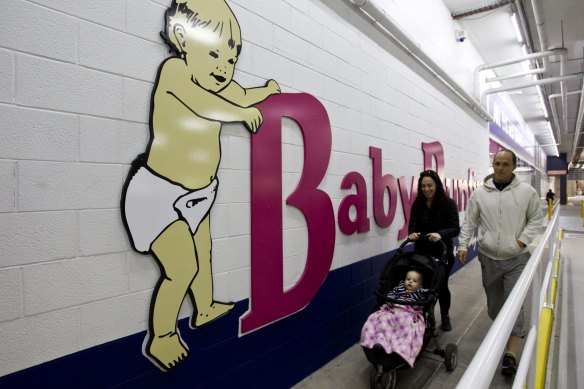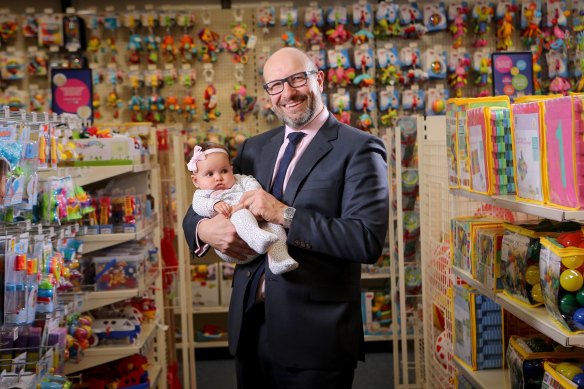Few items fit the definition of “essential spending” better than prams, cots and baby clothes.
These infant goods are ASX-listed retailer Baby Bunting’s bread and butter, and the business has become a major force in selling the basics – and extra bells and whistles – to Australians for their little ones.
Baby Bunting saw profits plunge in the first half of 2023. Credit: Louie Douvis
But while the company’s core products are some of the least likely victims of a spending slowdown, Baby Bunting has been flagging tough conditions. Profits for the first half of this year collapsed by 67 per cent and its share price is down by more than 57 per cent over the past 12 months.
Sales grew strongly during the lockdown era when Baby Bunting stores were allowed to remain open when many other retailers shuttered. Now the business has to adjust to the post-pandemic trading environment, where families are being increasingly savvy when it comes to kitting out their nurseries.
The company is also on the search for a new boss, confirming when it delivered its half-year results that long-serving managing director Matt Spencer will leave his post later this year.
After a turbulent few months, stock watchers are trying to work out whether the market has been too tough on the company, which still has national growth plans in the works.
Industry: Baby and nursery goods retail.
Main products: Prams, car seats, baby clothes and accessories.
Key figures: Chief executive Matt Spencer (who will exit the company this year), chair Melanie Wilson.
How it started: The business was founded when the Nadelman family opened a single baby goods store in the Melbourne suburb of Balwyn in 1979. The company had grown to more than 20 stores before its share market float in 2015.
How it’s going: The business listed on the ASX in 2015 with an offer price of $1.40. Shares closed at $2.06 before Easter but went as high as $6.58 in April 2021 thanks to the company’s COVID lockdown boost.
Long-time Baby Bunting CEO Matt Spencer will depart at the end of the year.Credit: Wayne Taylor
The bull case: Optimistic observers are looking through Baby Bunting’s short-term challenges and towards its future aspirations.
The company told investors at its February update that shoppers were spending less on consumer staples like clothing and toys, and directing more of their spending towards discount department stores like Kmart for these purchases.
Wilsons analysts still see the company as a dominating force in the baby goods market, though, and say the business can reach $1 billion in annual sales once it completes plans to open another 50 stores in the coming years.
“We believe Baby Bunting has been oversold, and provides attractive value for investors able to look through near-term headwinds and recognise the opportunity with strong revenue growth, gross margin expansion and earnings growth medium-term,” analyst Tom Camilleri said when initiating coverage of the stock at the end of last month. Wilsons has an overweight rating on the company and a price target of $2.70.
Citi’s analyst team says the outlook for the company is uncertain, particularly because the macroeconomic environment is continuing to weaken, but also sees long-term potential in the business.
“Baby Bunting still has a number of long-duration growth strategies, which appear intact,” Citi’s equities team said after the company reported its half-year numbers.
The bear case: More cautious stock watchers have their eye on same-store sales growth at Baby Bunting, and are trying to predict how the business will perform if shoppers direct a larger portion of their spending on infant goods to other retailers, like discount department stores.
Back in February, the company told investors that comparable store sales were down by 2.1 per cent year-to-date. The business reaffirmed its profit guidance, saying it expects net profit after tax for the full year to come in at between $21.5 million and $24 million.
Macquarie’s analysts said the retailer’s run rate was below their forecasts, and noted that the numbers suggest the company is relying on a strong second half to meet their targets. “We remain cautious given the significant 2H23 earnings skew required to meet guidance,” they said.
The composition of sales was also a concern, with click-and-collect orders dropping by 30.2 per cent in the first half. The Macquarie team also noted the drop in “consumer staples” sales, like clothes and nappies, and softening demand for toys and “play time” goods.
“This category includes Playgear, which is high margin, with management noting this category is further normalising post-COVID,” Macquarie’s retail team said.
- Advice given in this article is general in nature and is not intended to influence readers’ decisions about investing or financial products. They should always seek their own professional advice that takes into account their own personal circumstances before making any financial decisions.
The Business Briefing newsletter delivers major stories, exclusive coverage and expert opinion. Sign up to get it every weekday morning.
Most Viewed in Money
From our partners
Source: Read Full Article



